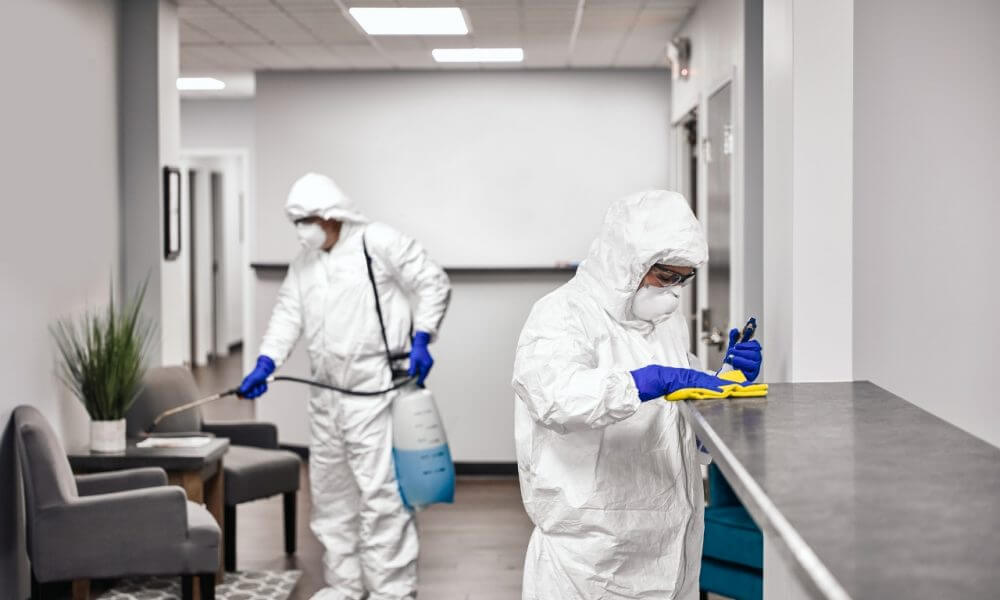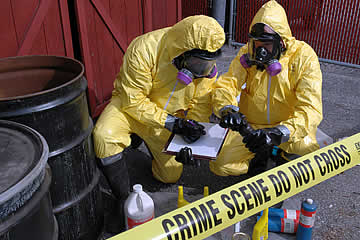Professional Blood Cleanup: Making Sure Safe and Thorough Decontamination
Professional Blood Cleanup: Making Sure Safe and Thorough Decontamination
Blog Article
Expert Biohazard Cleaning and Decontamination for Blood, Bodily Fluids, and Hazardous Materials
The prospective wellness risks connected with direct exposure to biohazards highlight the crucial demand for meticulous handling and complete cleanup. As we navigate the complex landscape of biohazard cleanup, comprehending the nuances of regulations, conformity, and the specialized devices at play comes to be necessary in ensuring a extensive and risk-free decontamination process.
Wellness Threats of Biohazard Exposure
Exposure to biohazards presents substantial health dangers that can cause severe consequences for neighborhoods and individuals alike. Biohazards include a large range of biological substances, including blood, bodily liquids, mold, bacteria, infections, and various other possibly transmittable products. When people enter into call with these biohazards, whether via accidents, improper handling, or environmental exposure, they face the threat of having severe illnesses or diseases.
Among the main health and wellness threats linked with biohazard direct exposure is the transmission of transmittable illness. Bloodborne microorganisms such as HIV, hepatitis B and C, and different bacteria can be present in biohazardous products, posturing a straight danger to human health and wellness. Inhaling airborne biohazards like mold and mildew spores or entering call with polluted surfaces can also bring about respiratory system concerns, allergic reactions, and other unfavorable health results.
In addition, biohazard direct exposure can have long-lasting health and wellness implications, with some diseases showing up years after the preliminary get in touch with (Blood Cleanup). As a result, it is important to prioritize correct biohazard cleansing and decontamination to mitigate these wellness dangers and make sure the safety and security of individuals and communities

Specialized Training for Biohazard Cleaning
When it concerns handling biohazard cleaning efficiently and securely, specialized training plays a fundamental function in making sure proper decontamination treatments are followed. Biohazard clean-up needs details understanding and abilities to properly mitigate dangers linked with bloodborne pathogens, bodily liquids, and unsafe materials. Experts learnt biohazard cleanup undertake rigorous instruction on exactly how to securely handle, remove, and get rid of biohazardous products to protect against contamination and exposure.
Specialized training for biohazard cleanup covers a range of vital topics, including appropriate personal protective devices (PPE) usage, bloodborne microorganism understanding, purification methods, and contaminated materials disposal procedures. People trained in biohazard clean-up are geared up with the required expertise to assess contamination levels, recognize possible threats, and apply ideal cleaning treatments in conformity with governing criteria.
Continual training and education and learning are critical in the field of biohazard cleanup to stay upgraded on the most up to date decontamination technologies, safety methods, and laws. By purchasing specialized training, biohazard cleanup professionals can properly reply to emergency cleaning scenarios and protect both public health and the setting.
Value of Proper Purification Methods
Utilizing correct decontamination strategies is essential in biohazard cleanup to successfully get rid of hazardous products and minimize wellness threats. Effective purification not only ensures the elimination of noticeable traces of blood, bodily liquids, and various other biohazards however additionally targets undetectable pathogens that might pose severe health dangers if not effectively gotten rid of. By complying with stringent purification methods, trained experts can dramatically reduce the danger of direct exposure to dangerous microbes, infections, and germs that can lead to infections or illness.
Proper decontamination strategies entail the use of specific tools and anti-bacterials that are specifically created to counteract biohazards effectively. Thorough cleaning and disinfection of click to investigate polluted locations are essential to avoid the spread of microorganisms and make certain a safe environment for residents. Furthermore, the right disposal of biohazardous waste complying with purification treatments is vital in protecting against contamination of other surface areas or people.

Equipment and Devices for Safe Cleaning
When dealing with blood, bodily liquids, or hazardous materials, biohazard cleansing experts rely on specialized equipment to reduce direct exposure threats and completely decontaminate the afflicted location. Additionally, biohazard cleansing kits including disinfectants, absorptive materials, and biohazard bags are utilized to safely include and dispose of polluted products.
Advanced cleaning devices like hospital-grade anti-bacterials, HEPA-filtered vacuums, and fogging devices are used to disinfect surfaces and get rid of biohazards efficiently. Specialized tools such as sharps containers and biohazard garbage disposal bins are made use of to safely take care of sharp items and biohazardous waste products. By using the appropriate tools and devices, biohazard cleansing experts can ensure an extensive cleanup procedure that focuses on safety and minimizes health dangers for both workers and owners of the afflicted space.
Rules and Conformity in Biohazard Cleansing
Correct adherence to guidelines and compliance requirements is critical in biohazard cleaning to ensure the security of both personnel and the setting. Government firms such as OSHA (Occupational Safety and Health Administration) and the EPA (Environmental Protection Company) have developed certain standards for biohazard clean-up treatments to reduce health and wellness risks and environmental contamination. These laws cover a variety of facets consisting of the handling, transportation, and disposal of biohazardous materials, along with the necessary training and protective equipment needed for personnel entailed in the clean-up procedure.
Biohazard cleaning firms should stay updated with these guidelines to ensure that their operations fulfill the needed safety criteria. Failure to follow these policies can cause extreme effects, including fines, legal activity, and endangering the health of individuals and the atmosphere. By complying with stringent policies and conformity measures, biohazard cleansing companies can efficiently mitigate dangers and link guarantee a comprehensive and secure clean-up process for all celebrations entailed.
Final Thought
To conclude, biohazard cleaning and decontamination require customized training, appropriate strategies, and adherence to regulations. Direct exposure to blood, physical liquids, and dangerous materials positions considerable health threats, making it vital to utilize the ideal equipment and devices for secure cleaning. By adhering to stringent protocols and standards, professionals can effectively alleviate the risks connected with biohazard direct exposure and make certain the security of both themselves and others.
As we navigate the elaborate landscape of biohazard cleaning, understanding the nuances of regulations, compliance, and the customized tools at play comes to be imperative in making certain a detailed and safe purification procedure. (Blood Cleanup)
When it comes to taking care of biohazard cleaning successfully go and securely, specialized training plays an essential function in making certain correct decontamination procedures are followed.Using appropriate purification methods is critical in biohazard cleaning to efficiently eliminate harmful products and reduce health and wellness dangers. Furthermore, biohazard cleansing packages including disinfectants, absorptive materials, and biohazard bags are used to safely dispose and include of polluted things.
Federal government agencies such as OSHA (Occupational Safety And Security and Wellness Management) and the EPA (Environmental Defense Company) have actually established specific standards for biohazard cleanup treatments to minimize health and wellness threats and ecological contamination.
Report this page